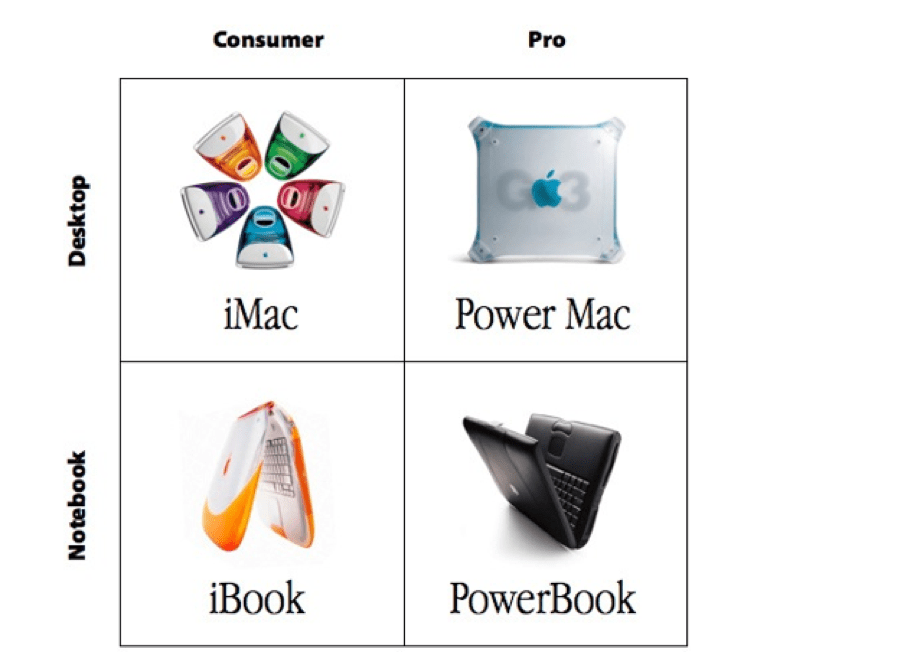Something both powerful and yet incredibly simple—the very epitome of Jobs' genius.
The year was 1997. Apple was at a crossroads. It had wandered far from Jobs' original vision. Twelve years after his tumultuous departure the company was bleeding cash and on the verge of bankruptcy. It was losing a battle with Microsoft's Windows operating system, allowing clones of its desktop computers, and taking a scattershot approach to developing dozens of disparate products. In Jobs' view, Apple had lost its vision.
But Jobs had a vision. He recognized that Apple owned a valuable, albeit tarnished brand. He also saw change taking place: a new world of personal media and communication devices. A future where an innovative and agile company could outmaneuver desktop giants Microsoft, Intel, and Dell.
Jobs also knew he had a problem. His vision was going to take Apple in a completely new direction. In order to gain consensus he had to present his strategy to the company's management in a clear and yet impactful way.
So what did he do? He walked up to a white board and drew a simple four-quadrant matrix.
Jobs set forth Apple's revamped strategy in one diagram. Four markets, four products, one crystal-clear vision: Apple has a computing device for anyone, anywhere. Simple, yet incredibly powerful. Anyone who looks at it can understand it without a single word needing to be spoken.

This is the essence of visual strategic thinking.
Studies show that most people are visual thinkers. Steve Jobs understood this and used it to communicate his vision, whether in a small meeting or at his famous Apple World presentations.
The good news is that anyone can tap the same powerful communication method that Jobs employed. Here's how.
Visual strategic thinking, like Jobs' four-quadrant visual, is built upon four key components:
Strategic thinking is all about the big picture. But the big picture can be difficult to explain. Using pictures, charts, and diagrams is a means to express those thoughts to others so that they can see them, too. The old adage, "a picture is worth a thousand words" holds true when communicating complex ideas such as a strategic plan. Like Jobs' matrix example, words alone simply can't convey a message as thoroughly as a concise visual image.
The image below compares a traditional page of text to a concise diagram. Big picture thinking is best presented with a focus on a few key elements, not by delving into too much detail.
Because people think visually, an image like this one is more effective than a page of text. It's easier to understand, retain, and recall information presented in this manner.
Simply put, the big picture is easier to see in a picture.
To engage people, use a visual. Spreadsheets, slide decks, and reports are rigid. They are useful as supporting collateral, but they imply one-way communication. This allows people to easily tune out.
When doing on-site strategy work, many consultants bring in cases of sticky notes and dry-erase markers in every color imaginable. Why? The act of getting people out of their seat and up to a white board fosters collaboration. The majority of people simply can't resist sketching, highlighting, and commenting when charts and whiteboards are available. And you don't need to bring in a graphics artist—even bad visuals get people engaged. A room filled with engaged people works better on big ideas like strategy; decisions will come easier as well.
People appreciate a message that is clear. Jobs' matrix couldn't be much clearer. Rather than locking away a company's grand plans in a binder, that diagram could hang on a wall.
When everyone knows the plan, it fosters openness and trust. The direction of the company is transparent. Research shows a strong correlation between employee happiness and company transparency. Keep your message clear and open. A simple, strategic visual helps foster this.
All of this big picture thinking, engaged collaboration, and transparency falls flat without execution. But that is the beauty of visual strategic thinking. Each element builds on the previous. A clear big picture leads to engaged employees, who see the grand vision the same way you do. Engaged employees help get everyone involved. With a clear vision and collaboration, you inherently have greater transparency throughout your organization because the strategic message is very clear and open. The reason is simple: engaged, happy employees execute better. A key lesson is that visual strategic thinking is a cycle, moving right into supporting execution with additional visuals, winding up back at the white board with visuals and an engaged team.
Visual strategic thinking can seem a bit nebulous, and in many ways it is. But that is not too different from normal strategic thinking. Most strategic thinking today involves some kind of visual already. It's not as big of a leap as you might think. I encourage you to try it and then see the results.